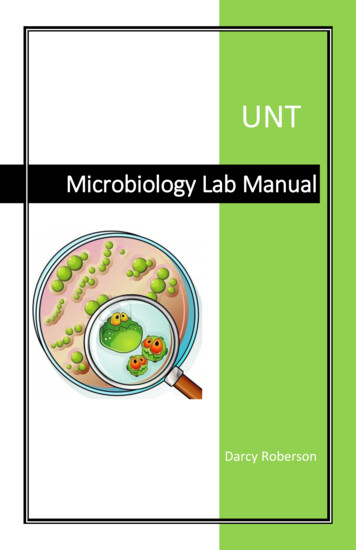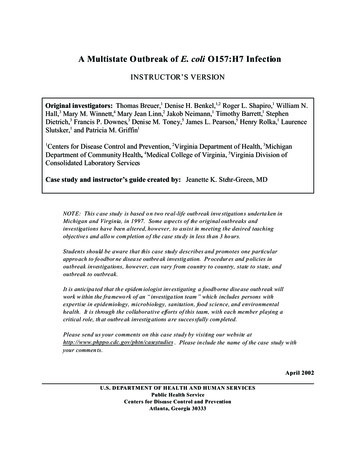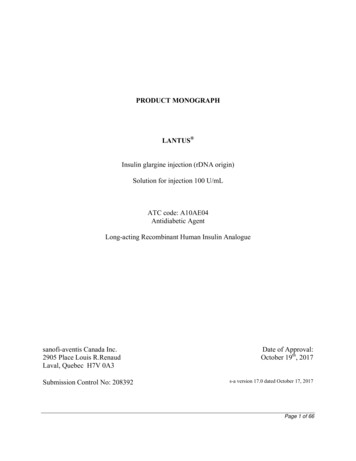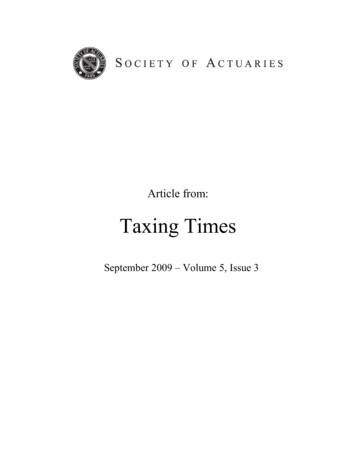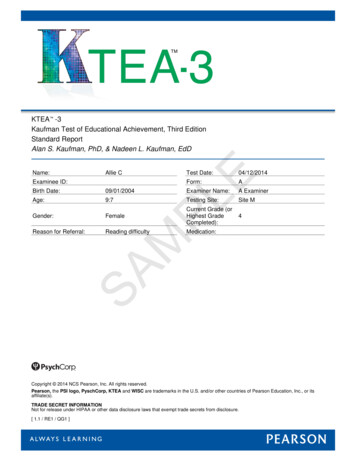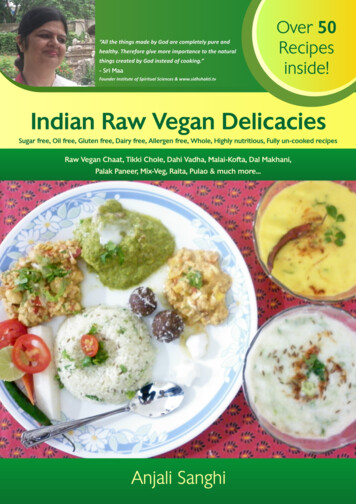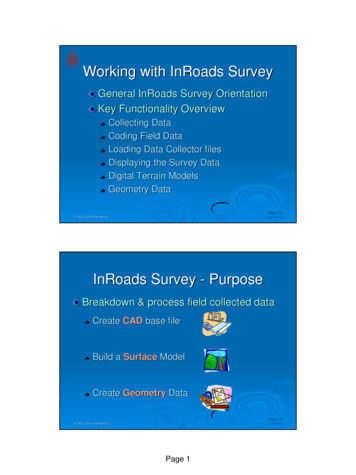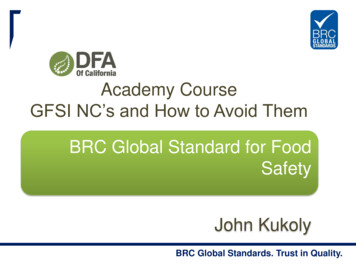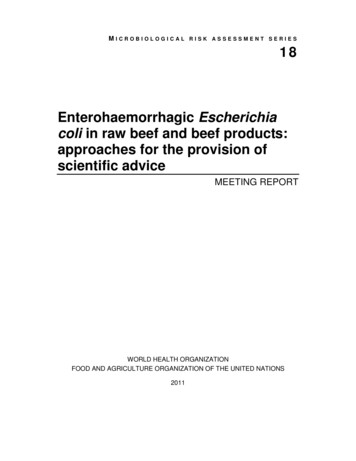
Transcription
MICROBIOLOGICAL RISK ASSESSMENT SERIES18Enterohaemorrhagic Escherichiacoli in raw beef and beef products:approaches for the provision ofscientific adviceMEETING REPORTWORLD HEALTH ORGANIZATIONFOOD AND AGRICULTURE ORGANIZATION OF THE UNITED NATIONS2011
The designations employed and the presentation of material in this information product do notimply the expression of any opinion whatsoever on the part of the Food and Agriculture Organizationof the United Nations or of the World Health Organization concerning the legal or development statusof any country, territory, city or area or of its authorities, or concerning the delimitation of its frontiersor boundaries.The mention of specific companies or products of manufacturers, whether or not these have beenpatented, does not imply that these have been endorsed or recommended by FAO or WHO inpreference to others of a similar nature that are not mentioned.All reasonable precautions have been taken by the World Health Organization and the Food andAgriculture Organization of the United Nations to verify the information contained in this publication.However, the published material is being distributed without warranty of any kind, either expressed orimplied.The responsibility for the interpretation and use of the material lies with the reader. In no eventshall the World Health Organization and the Food and Agriculture Organization of the United Nationsbe liable for damages arising from its use. This report contains the collective views of an internationalgroup of experts and does not necessarily represent the decisions or the stated policy of FAO or ofWHO.WHO Library Cataloguing-in-Publication Data1.Escherichia coli infections. 2.Meat products - microbiology. 3.Food poisoning - preventionand control. 4.Food contamination. 5.Risk assessment. I.World Health Organization. II.Food andAgriculture Organization of the United Nations. III.Series.ISBN 978-92-4-154824-3 (NLM classification: WC 290)ISBN 978-92-5-107010-9ISSN 1726-5274Recommended citationFAO/WHO [Food and Agriculture Organization of the United Nations/World HealthOrganization]. 2011. Enterohaemorrhagic Escherichia coli in raw beef and beef products: approachesfor the provision of scientific advice: meeting report. Microbiological Risk Assessment Series No. 18.Geneva. 126 pp.All rights reserved. Reproduction and dissemination of material in this information product foreducational or other non-commercial purposes are authorized without any prior written permissionfrom the copyright holders provided the source is fully acknowledged. Reproduction of material in thisinformation product for resale or other commercial purposes is prohibited without written permissionof the copyright holders. Requests for permission to reproduce or translate WHO publications shouldbe addressed to WHO Press through the WHO web site(http://www.who.int/about/licensing/copyright form/en/index.html). FAO and WHO 2011
— iii —ForewordThe Members of the Food and Agriculture Organization of the United Nations (FAO) and ofthe World Health Organization (WHO) have expressed concern regarding the level of safetyof food at both national and international levels. Increasing foodborne disease incidence overthe last decades seems, in many countries, to be related to an increase in disease caused bymicroorganisms in food. This concern has been voiced in meetings of the Governing Bodiesof both Organizations, and in the Codex Alimentarius Commission. It is not easy to decidewhether the suggested increase is real or an artefact of changes in other areas, such asimproved disease surveillance or better detection methods for microorganisms in foods.However, the important issue is whether new tools or revised and improved actions cancontribute to our ability to lower the disease burden and provide safer food. Fortunately newtools that can facilitate actions seem to be on their way.Over the past decade, Risk Analysis—a process consisting of risk assessment, riskmanagement and risk communication—has emerged as a structured model for improving ourfood control systems, with the objectives of producing safer food, reducing the numbers offoodborne illnesses and facilitating domestic and international trade in food. Furthermore, weare moving towards a more holistic approach to food safety, where the entire food chainneeds to be considered in efforts to produce safer food. As with any model, tools are neededfor the implementation of the risk analysis paradigm.Risk assessment is the science-based component of risk analysis. Science today providesus with in-depth information on life in the world we live in. It has allowed us to accumulate awealth of knowledge on microscopic organisms, their growth, survival and death, even theirgenetic make-up. It has given us an understanding of food production, processing andpreservation, and of the link between the microscopic and the macroscopic world and how wecan benefit from as well as suffer from these microorganisms. Risk assessment provides uswith a framework for organizing all this data and information and to better understand theinteraction between microorganisms, foods and human illness. It provides us with the abilityto estimate the risk to human health from specific microorganisms in foods and gives us atool with which we can compare and evaluate different scenarios, as well as to identify thetypes of data necessary for estimating and optimizing mitigating interventions.Microbiological risk assessment can be considered as a tool that can be used in themanagement of the risks posed by foodborne pathogens and in the elaboration of standardsfor food in international trade. However, undertaking a microbiological risk assessment(MRA), particularly quantitative MRA, is recognized as a resource-intensive task requiring amultidisciplinary approach. Yet foodborne illness is among the most widespread publichealth problems, creating social and economic burdens as well as human suffering, making ita concern that all countries need to address. As risk assessment can also be used to justify theintroduction of more stringent standards for imported foods, a knowledge of MRA isimportant for trade purposes, and there is a need to provide countries with the tools forunderstanding and, if possible, undertaking MRA. This need, combined with that of theCodex Alimentarius for risk-based scientific advice, led FAO and WHO to undertake aprogramme of activities on MRA at the international level. The Nutrition and ConsumerProtection Division, FAO, and the Department of Food Safety and Zoonoses, WHO, are thelead units responsible for this initiative. The two groups have worked together to develop the
— iv —area of MRA at the international level for application at both the national and internationallevels.This work has been greatly facilitated by the contribution of people from around the worldwith expertise in microbiology, mathematical modelling, epidemiology and food technology,to name but a few. This Microbiological Risk Assessment series provides a range of data andinformation to those who need to understand or undertake MRA. It comprises riskassessments of particular pathogen-commodity combinations, interpretative summaries of therisk assessments, guidelines for undertaking and using risk assessment, and reportsaddressing other pertinent aspects of MRA.We hope that this series will provide a greater insight into MRA, how it is undertaken andhow it can be used. We strongly believe that this is an area that should be developed in theinternational sphere, and have already from the present work clear indications that aninternational approach and early agreement in this area will strengthen the future potential foruse of this tool in all parts of the world, as well as in international standard setting. We wouldwelcome comments and feedback on any of the documents within this series so that we canendeavour to provide Member countries, Codex Alimentarius and other users of this materialwith the information they need to use risk-based tools, with the ultimate objective of ensuringthat safe food is available for all consumers.Mr Samuel C. JutziDr M. Maged YounesOfficer-in-ChargeNutrition and Consumer Protection DivisionFood and Agriculture Organization of theUnited NationsDirectorDepartment of Food Safety and ZoonosesWorld Health Organization
—v—ContentsContributors (Meeting participants)ExpertsResource personDeclarations of interestAcknowledgementsAbbreviations1. Introduction1.1 Background1.2 Objectives1.3 Scope1.3.1 Hazards of concern1.3.2 EHEC1.3.3 Food commodities of concern2. Review of the risk assessments undertaken to date and theirapplication2.1 Introduction2.2 Overview of the risk assessments2.2.1 Quantitative risk assessment for Escherichia coli O157:H7 in groundbeef hamburgers (Cassin et al., 1998)2.2.2 Shiga toxin-producing E. coli in Ground Beef manufactured fromAustralian Beef: Process Improvement2.2.3 Draft risk assessment of the public health impact of Escherichia coliO157 in ground beef (USDA-FSIS, 2001)2.2.4 Risk assessment of Shiga-toxin producing Escherichia coli O157 insteak tartare in the Netherlands (Nauta et al., 2001)2.2.5 E. coli O157:H7 in beef burgers produced in the Republic of Ireland:A quantitative microbial risk assessment (Teagasc, 2006)2.3 Common features and lessons learned3. Key management issues associated with EHEC in raw andready-to-eat beef products3.1 Introduction3.2 Issues for consideration at pre-harvest stage3.3 Issues for consideration at harvest stage (transport, lairage, slaughterand dressing)3.4 Issues for consideration at post-harvest stage3.5 Other relevant issues3.5.1 Mechanically tenderized meat3.5.2 Intrinsically high risk products (risk 181920212122
— vi —3.5.3 Validation, monitoring and verification, and establishment ofequivalence3.5.4 Hazard characterization (including dose-response)22234. Designing approaches for the provision of scientific advice244.1 Introduction4.2 Flexibility in approach to provision of advice to risk managers4.3 Asking risk management questions4.4 Application of risk assessment4.5 Future application of existing risk assessments24242631314.5.1 Pre-harvest (Live animal)4.5.2 Harvest (transport, lairage, slaughter and dressing)4.5.3 Post-harvest (processing, transport, storage, distribution, preparation,consumption)4.5.4 Assessment of equivalence4.5.5 Dose response5. Data gaps and future research needs5.1 Other information gaps5.1.1 Non-O157 EHECs5.1.2 Dose response5.1.3 Emerging issues323232333334343435366. Conclusions and recommendations377. References39Annex 1 – Background paper 1Overview of existing risk assessments on enterohaemorrhagicEscherichia coli in meat and meat products42A1. IntroductionA1.1. EHEC dose-response analyses4343A1.1.1 Cassin et al., 1998A1.1.2 Lammerding et al., 1999A1.1.3 USDA-FSIS 2001A1.1.4 Nauta et al., 2001A1.1.5 Duffy et al., 2005A1.1.6 Strachan et al., 2005434545474950A1.2. Other modelling issuesA1.2.1 Addressing uncertainty and variabilityA1.2.2 Detecting differencesA1.2.3 Thorough documentationA1.2.4 Evidence vs intuition5151535454A1.3. References56Appendix to Annex 158
— vii —Annex 2 – Background paper 2An overview of Escherichia coli O157 along the meat chain60A2.1. Introduction60A2.2. Hazard identification61A2.2.1 Characteristics of Escherichia coli O157A2.2.1.1 Genus Escherichia and enterohaemorrhagic E. coliA2.2.1.2 Definitions associated with E. coli O157A2.2.1.3 Other (i.e. non-O157) serotypes of E. coli that can cause humanfoodborne illnessA2.2.2 Overview of E. coli O157 infectionsA2.2.2.1 IncidenceA2.2.2.2 Routes of infection61616263646466A2.3. Hazard characterization68A2.3.1 E. coli O157 infections68A2.3.1.1 Basic mechanism of E. coli O157 infectionA2.3.1.2 Manifestations of human infectionA2.3.1.3 Meats associated with E. coli O157 infectionsA2.3.2 Dose-response relationshipA2.3.2.1 Infectious dose conceptA2.3.2.2 ‘Probability of infection’ conceptA2.3.2.3 Factors affecting dose-responseA2.4. Exposure assessmentA2.4.1 IntroductionA2.4.2 E. coli O157 along the meat chain – Prevalence and incidencedataA2.4.2.1 Pre-harvest phaseA2.4.2.2 Harvest phaseA2.4.2.3 Post-harvest phaseA2.4.3 E. coli O157 along the meat chain – Concentration dataA2.4.4 Microbial ecology of E. coli O157 in meatsA2.4.5 Global trends in meat production and consumptionA2.4.5.1 Trends in meat productionA2.4.5.2 Trends in meat consumption686970727272727777777781868989919193
— viii —A2.5. Knowledge gaps and improvements neededA2.5.1 Hazard identificationA2.5.2 Hazard characterizationA2.5.3 Exposure assessmentA2.5.3.1 Pre-harvestA2.5.3.2 HarvestA2.5.3.3 Post-harvestA2.6. ReferencesAnnex 3 – Summary of existing risk assessmentsA3.1. Quantitative risk assessment for Escherichia coli O157:H7 inground beef hamburgers (Cassin et al., 1998).A3.2. Shiga toxin-producing E. coli in Ground Beef manufactured fromAustralian Beef: Process Improvement.A3.3. Draft risk assessment of the public health impact of Escherichiacoli O157 in ground beef (USDA-FSIS, 2001)A3.4. Risk assessment of Shiga-toxin producing Escherichia coli O157in steak tartare in the Netherlands (Nauta et al, 2001).A3.5. E. coli O157:H7 in beef burgers produced in the Republic ofIreland: A quantitative microbial risk assessment (Teagasc, 2006).A3.6. SummaryA3.7. References9494949595959697117117118118121124125126
— ix —Contributors(Meeting participants)ExpertsWayne AndersonFood Safety Authority of Ireland, IrelandJeppe BoelDanish Institute for Food and Veterinary Research, DenmarkSava BuncicUniversity of Novi Sad, SerbiaFrancis ButlerUniversity College Dublin, IrelandJohn CowdenHealth Protection Scotland, United KingdomGeraldine DuffyTeagasc, Ashtown Food Research Centre, IrelandDan EnglejohnUnited States Department of Agriculture Food Safety and InspectionService, United States of AmericaTeresa EstradaCinvestat, MexicoSeamus FanningUniversity College Dublin, IrelandAamir FazilPublic Health Agency of Canada, CanadaIan JensonMeat & Livestock Australia, AustraliaMicheál O'MahonyFood Safety Authority of Ireland, IrelandMark PowellUnited States Department of Agriculture Office of Risk Assessmentand Cost-Benefit Analysis,United States of AmericaEmma SnaryVeterinary Laboratories Agency, United KingdomResource personAlan ReillyFood Safety Authority of Ireland, IrelandDeclarations of interestAll participants completed a Declaration of Interest form in advance of the meeting. Nonewere considered to present any potential conflict of interest.
—x—AcknowledgementsThe Food and Agriculture Organization of the United Nations (FAO) and the World HealthOrganization (WHO) would like to express their appreciation to all those who contributed tothe preparation of this report through the provision of their time and expertise, data and otherrelevant information. In particular the work of Sava Buncic and Mark Powell in preparing thebackground discussion papers for the meeting is acknowledged.The meeting was hosted by the Food Safety Authority of Ireland (FSAI). FAO and WHOwould like to extend their appreciation to Alan Reilly, Deputy Chief Executive, and his stafffor their extensive support in the implementation of this meeting.The preparatory work and expert meeting convened to prepare this report was coordinatedby the Secretariat of the Joint FAO/WHO Expert Meetings on Microbiological RiskAssessment (JEMRA). This included Sarah Cahill and Maria de Lourdes Costarrica in FAOand Peter Karim Ben Embarek and Jenny Bishop in WHO. The work was supported andfunded by the FAO Nutrition and Consumer Protection Division and the WHO Departmentof Food Safety and Zoonoses.Final editing for conformity and preparation for printing was by Thorgeir Lawrence.
— xi eagascTTPUSDAVTVTECWHOattaching and effacing [lesions on the surface of epithelial cells]Codex Alimentarius CommissionCodex Committee on Food HygieneCenters for Disease Control and Prevention [USA]Colony forming unitsEnterohaemorrhagic Escherichia coliFood and Agriculture Organization of the United NationsFood and Drug Administration [of the United States of America]Food Safety Authority of IrelandFood Safety and Inspection Service [USDA]Good hygiene practiceGood manufacturing practiceHazard analysis and critical control pointsHaemorrhagic colitisHaemolytic uraemic syndromeInternational Commission on Microbiological Specifications for FoodsJoint FAO/WHO Expert Meetings on Microbiological Risk AssessmentMeat and Livestock AustraliaMaximum likelihood estimatesPulsed field gel electrophoresisQuantitative microbiological risk assessmentShiga toxinShiga toxinShiga toxin producing E. coliAgriculture and Food Development Authority [of Ireland]Thrombotic thrombocytopaenic pupuraUnited States Department of AgricultureVerocytotoxin or verotoxinVerotoxigenic E. coliWorld Health Organization
E. coli in raw beef and beef products – Approaches for the provision of scientific advice11. Introduction1.1 BackgroundEscherichia coli O157:H7 is a member of the enterohaemorrhagic E. coli (EHEC) group ofand was first identified as a human pathogen in 1982 when strains of a previously uncommonserotype, O157:H7, were implicated in two outbreaks of haemorrhagic colitis (HC) in theUnited States of America (Riley et al., 1983). Since then, outbreaks and sporadic cases ofEHEC O157:H7 infection continue to be reported in a number of countries throughout theworld. Outbreaks of infections from non-O157 serotypes of E. coli, including O26:H11,O103:H2, O104:H21, O111:H8 and O113:H21, are also regularly reported.The symptoms of infection from this group of organisms include bloody diarrhoea andsevere abdominal pain, but range from asymptomatic infection to death, with the incubationperiod ranging from one to eight days. Infection with EHEC may lead to furthercomplications, most notably haemolytic uraemic syndrome (HUS). HUS is characterized byacute kidney failure and is the leading cause of renal failure in young children.The incidence of EHEC varies by country. In 2004, the number of laboratory-confirmedcases in the European Union (17 member states) and Norway was 1.3 cases per 100 000population (EFSA, 2006), while in the same year the incidence in the United States ofAmerica was 0.9 cases per 100 000 people (Vugia et al., 2005). In 2001, the incidence inNew Zealand was reported to be 2 cases per 100 000 (Sneyd et al., 2002) and 0.2 cases per100 000 in Australia (OzFoodNet, 2001). The frequency of EHEC, and more specificallyHUS, appears to be the highest in Argentina, with estimates of approximately 22 cases ofHUS per 100 000 children aged 6 to 48 months (Lopez et al., 1997). While EHEC infectionshave also been reported for other parts of the world, including a number of African countries,specific incidence data are not always collected or readily available. EHEC infection andassociated diseases can occur in any age group; however, it seems that illness occurs mostoften in young children. For example, in Japan, the median age for EHEC illness has beenreported to be 8 years (Kawamura, Yamazaki and Tamai, 1999). Children less than five yearsof age appear to be the most susceptible to HUS, while EHEC infections in the elderly leadmore often to thrombotic thrombocytopaenic pupura (TTP) (Banatvala et al., 2001).EHECs have been isolated from various domestic animals and wildlife, including cattle,sheep, swine, goats and deer. Ruminants, and in particular cattle, are considered a majorreservoir of EHEC. While multiple sources and routes of transmission are now recognized,data based on outbreaks and sporadic infections indicate beef and beef products as the mostfrequently identified source of foodborne EHEC infection. In particular, undercooked groundbeef products have emerged as an important source of foodborne infection. Other foodbornesources include milk and dairy products (e.g. unpasteurized milk, cheese from raw milk),fresh produce (e.g. sprouts, salads), drinks (e.g. apple cider or juice) and water. Dozens ofnew outbreaks have been reported implicating different sources and illustrating themultifaceted epidemiology of EHEC infections.The Codex Committee on Food Hygiene (CCFH) is considering addressing the need forrisk-based control of EHEC. A risk profile has been prepared as the basis for further work inthis area (CCFH, 2005). The Committee has noted that no international risk assessment has
2Meeting Reportbeen undertaken on this issue and suggested that this could be the next step in order to moveforward (CAC, 2004).Taking into consideration the ongoing public health problem of EHEC in their membercountries, the impact of this pathogen on meat trade, and the suggestion from Codex toundertake a risk assessment on this issue, FAO and WHO consider that this highlights theneed for urgent attention at both national and international level to develop appropriatemanagement interventions. Therefore, as part of JEMRA activities, FAO and WHO, togetherwith the Food Safety Authority of Ireland (FSAI), convened an inception meeting onenterohaemorrhagic E. coli in raw meat and meat products from 4–7 September 2006 inDublin, Ireland. This meeting was convened to provide guidance to FAO and WHO on theappropriate steps in the development of this activity before embarking on any risk assessmentwork.As well as providing guidance to FAO and WHO in their future work on EHEC, theoutcome of the meeting will be made available to CCFH to assist the committee in its effortsto develop risk management guidance documents on EHEC and to facilitate its interactionwith FAO and WHO on defining and clarifying the scientific advice needed for this work.To assist the participants in their deliberations, FAO and WHO commissioned thepreparation of two background papers: one provided an update on the current state ofknowledge on the bacteria and related issues at the time of the meeting, while the other gavea description and analysis of the risk assessments that had already been undertaken in anumber of Member States. These two documents are appended as Annexes 1 and 2 to thisreport.1.2 ObjectivesIt has been noted that a number of risk assessments have already been undertaken on EHECin meat and meat products and that there is experience in some countries on the riskmanagement of this issue. The meeting was convened to review the current state ofknowledge on EHEC in terms of existing risk assessments and related information. In doingso, the meeting was requested to consider the risk management actions, if any, that resultedfrom those risk assessments and to identify what was useful about the existing riskassessments from a risk management perspective, as well as identifying the strengths andweaknesses of the risk assessments. Based on this review and discussion, a roadmap forfuture FAO/WHO activities in this area would be developed to inform the process of riskbased management of EHEC in raw beef and beef products in CCFH and in membercountries.The specific objectives of the meeting were to: Review the existing risk assessments on EHEC in terms of (a) their fulfilling their scopeand providing the basis for scientifically-based risk-management actions; and (b) theirpotential application (in whole or on a modular basis) to the development of a riskassessment at the international level. Consider the risk management actions, if any, taken to date that were based on riskassessment and identify the strengths and weakness of the risk assessments from a riskmanagement perspective, in particular identifying when and why the risk assessments didnot meet the needs of risk managers. Identify the key issues currently faced by risk managers in terms of addressing theproblems associated with EHEC in raw beef and beef products.
E. coli in raw beef and beef products – Approaches for the provision of scientific advice 3Considering the output of the above objectives and the existing data on EHEC in rawbeef and beef products, provide guidance to FAO and WHO on the specific areas to beaddressed in any future work on this issue, and how to address them.1.3 Scope1.3.1 Hazards of concernThe hazard of concern that was the focus of this meeting was EHEC. However, throughoutthis document specific mention is made of one particular EHEC, verotoxin producing E. coliO157:H7, because of its implication in the first recognized outbreak of EHEC infection. Inaddition, several other major outbreaks, coupled with its unique physiology (in terms ofEHEC) have resulted in E. coli O157:H7 being the EHEC most frequently referred to andmost extensively described in the literature.1.3.2 EHECVerocytotoxin producing Escherichia coli is a term used to describe strains of E. colicharacterized by the ability to produce verocytotoxin(s) (VT), or just verotoxins that arecapable of killing vero cells, a tissue culture line of monkey kidney cells. This group, oftenreferred to as verotoxigenic E. coli or VTEC, includes over 100 serogroups in addition toE. coli O157:H7. Furthermore, it is recognized that the terms Shiga toxin producing E. coli(STEC) and VTEC as well as the terms Shiga toxin(s) (ST or Stx) and verocytotoxin orverotoxin (VT) are used interchangeably worldwide. A more extensive description of therelevant terms is provided in Section A2.1 of Annex 2.EHEC is defined as a subgroup of VTEC/STEC associated with human diseases andwhich in addition to the verocytotoxin/shigatoxin producing capacity harbours additionalgenes that are important in virulence. These include the genes encoded in the pathogenicityisland designated LEE (locus of enterocyte effacement), which can cause attaching andeffacing lesions on the surface of epithelial cells (A/E factor, usually determined by thepresence of the intimin (eae gene) and a 60 MDa ‘virulence’ plasmid (usually determined bythe presence of the ehx gene). It should be noted that the clinical outcome of an infectionmight not necessarily include HC or HUS. In addition to E. coli O157, EHEC includes otherserotypes causing foodborne illness, such as O26, O111, O113 and O121.Due to the paucity of information on most other EHECs, the scope of this paper waslimited to E. coli O157:H7 or VTEC O157 when discussing strain- or serotype-specific data,on the assumption that this is where most of the data are available. However, assuming thatthe behaviour of E. coli O157:H7 would be similar to other relevant EHEC serotypes, theadvice provided would be applicable for most if not all EHECs. In other words, the strategyrecommended on how to control EHEC is based on our knowledge of O157:H7. The meetingnevertheless recognized that such a generalization may not be appropriate as moreinformation on other EHECs becomes available.1.3.3 Food commodities of concernIt is commonly accepted that the primary reservoirs of EHEC are farm ruminants, and inparticular cattle. It is, however, unclear to what extent EHEC can be considered ubiquitous incattle, and what the reasons are for the sporadic nature of EHEC and the variation inprevalence in cattle in different regions of the world.
4Meeting ReportThe main recognized routes of EHEC infection are: person-to-person transmission;contact with animals; foodborne transmission; and waterborne transmission. Only thefoodborne route is considered further in this document.Food vehicles implicated most frequently in outbreaks of EHEC infection have been rawor undercooked foods of bovine origin, especially undercooked ground beef andunpasteurized milk (CCFH, 2005). A number of case-control studies have identified groundbeef as an important risk factor for EHEC infection, with current data based on outbreaks andsporadic infections indicating that consumption of ground beef remains the single mostfrequently identified source of foodborne EHEC infection. Dry fermented meats, as well ascooked and fermented sausages, have also been implicated in reported outbreaks of EHECinfection. However, an increasing number of outbreaks have been associated with theconsumption of raw or minimally processed fruits and vegetables. Leafy green vegetables,such as lettuce, have been implicated in a number of large outbreaks of E. coli O157:H7,some of which had serious public health impacts (Hilborn, Mermin and Mshar, 1999; Martinet al., 1986; US FDA, 2006, 2007). These are an important source of human cases offoodborne illness due to EHEC as they are subject to contamination and eaten raw (CAC,2002).Thus, while recognizing the importance of other sources of foodborne EHEC infections,the meeting decided to restrict the scope of its work to raw ground beef and beef productsalong the entire food chain from primary production to consumption. This restriction was alsomotivated by the availability of data. Figure 1 illustrates the routes of transmission andproducts of concern considered during the meeting.
E. coli in raw beef and beef products – Approaches for the provision of scientific adviceHuman Reservoir5Environmental ReservoirAnimal ReservoirOther animals— sheep, pigs, pets, etc.CattleMilk and dairyproductsNon-animal productsBeef and beef ProductsPre-harvest (on-farm activities)Harvest(transport, lairage, slaughter, dressing)Pathway outsidethe scope of themeetingPathway withinthe scope of themeetingPost-harvest(boning, processing, distribution, retail,preparation, consumption)Primal cutse.g. beef jointsReady-to-eatprocessed beefproductse.g. fermented beefproductsRaw processedbeef productse.g. ground beef,mechanicallytenderized beefFigure 1. Routes of transmission of EHEC and products of concern considered during the meeting.
6Meeting Report2. Review of the risk assessments undertaken to date andtheir application2.1 IntroductionFive risk assessments addressing the risk of EHEC, and specifically E. coli O157 in rawground beef or similar comminuted products, have been under
the World Health Organization (WHO) have expressed concern regarding the level of safety of food at both national and international levels. Increasing foodborne disease incidence over the last decades seems, in many countries, to be related to an increase in d
